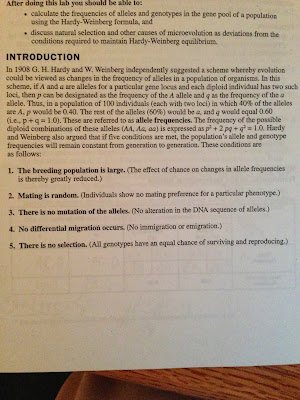The Hardy-Weinberg formula is:
Here is a Hardy- Weinberg Problem:
In certain African countries 4% of the newborn babies have sickle-cell anemia, which is a recessive trait. Out of a random population 1,000 newborn babies, how many would you expect of the three possible genotypes?
The first thing you look for is a q(recessive allele frequency) or q^2 (homozygous recessive). The q^2 in this problem is 4% of newborn babies. In order to find q you mush square root the 4%. So the value of q is 0.2. To find p you can just subtract 1-0.2, since you know that p+q=1. p=0.8, and q=0.2.
The problem also asks for the three possible genotypes (q^2, p^2, and 2pq). In order to find these values, you must multiply your values for q^2, p^2 and 2pq by the total population, 1000.
p=0.8
q=0.2
2pq=0.32
population=1000
Now we use these values to find the number of individuals in each genotype for this population
q^2*population=number of individuals with recessive trait(sickle-cell anemia)
(0.04)^2*1000=40 individuals
p^2*population=number of individuals with the dominant trait
(0.8)^2*1000=640 individuals
2pq*population= number of individuals with the heterozygous trait
(0.32)*1000=320 individuals


You could have done a problem to show your knowledge.
ReplyDelete